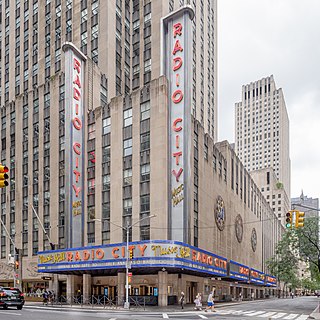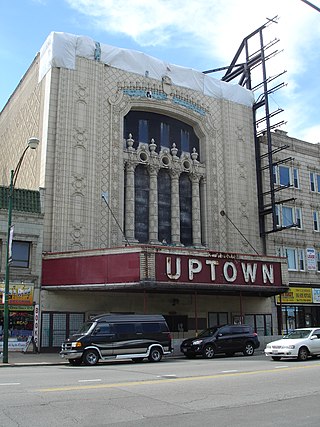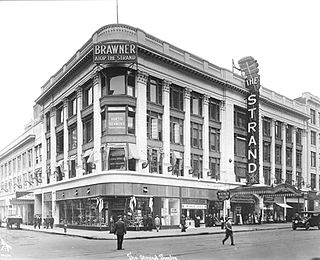
Sonja Henie was a Norwegian figure skater and film star. She was a three-time Olympic champion in women's singles, a ten-time World champion (1927–1936) and a six-time European champion (1931–1936). Henie has won more Olympic and World titles than any other ladies' figure skater. She is one of only two skaters to defend a ladies' singles Olympic title, the other being Katarina Witt, and her six European titles has only been matched by Witt.

Rockefeller Center is a large complex consisting of 19 commercial buildings covering 22 acres (89,000 m2) between 48th Street and 51st Street in the Midtown Manhattan neighborhood of New York City. The 14 original Art Deco buildings, commissioned by the Rockefeller family, span the area between Fifth Avenue and Sixth Avenue, split by a large sunken square and a private street called Rockefeller Plaza. Later additions include 75 Rockefeller Plaza across 51st Street at the north end of Rockefeller Plaza, and four International Style buildings on the west side of Sixth Avenue.

Radio City Music Hall is an entertainment venue and theater at 1260 Avenue of the Americas, within Rockefeller Center, in the Midtown Manhattan neighborhood of New York City. Nicknamed "The Showplace of the Nation", it is the headquarters for the Rockettes. Radio City Music Hall was designed by Edward Durell Stone and Donald Deskey in the Art Deco style.

Samuel Lionel "Roxy" Rothafel was an American theatrical impresario and entrepreneur. He is noted for developing the lavish presentation of silent films in the deluxe movie palace theaters of the 1910s and 1920s.

A movie palace is any of the large, elaborately decorated movie theaters built between the 1910s and the 1940s. The late 1920s saw the peak of the movie palace, with hundreds opening every year between 1925 and 1930. With the advent of television, movie attendance dropped, while the rising popularity of large multiplex chains in the 1980s and 1990s signaled the obsolescence of single-screen theaters. Many movie palaces were razed or converted into multiple-screen venues or performing arts centers, though some have undergone restoration and reopened to the public as historic buildings.

NBC Studios are located in the historic 30 Rockefeller Plaza in Manhattan, New York City. The building houses the NBC television network headquarters, its parent NBCUniversal, and NBC's flagship station WNBC, as well as cable news channel MSNBC.
Holiday on Ice is an ice show currently owned by Medusa Music Group GmbH, a subsidiary of CTS EVENTIM, Europe's largest ticket distributor, with its headquarters in Bremen, Germany.

The Ed Sullivan Theater is a theater at 1697–1699 Broadway, between 53rd and 54th Streets, in the Theater District of Midtown Manhattan in New York City. Built from 1926 to 1927 as a Broadway theater, the Sullivan was developed by Arthur Hammerstein in memory of his father, Oscar Hammerstein I. The two-level theater was designed by Herbert J. Krapp with over 1,500 seats, though the modern Ed Sullivan Theater was downsized to 370 seats by 2015. The neo-Gothic interior is a New York City landmark, and the building is on the National Register of Historic Places.

The Stanley Theater at Kennedy Boulevard and Pavonia Avenue is near Journal Square in Jersey City, New Jersey.

Ernö Rapée was a Hungarian-born American symphonic conductor in the first half of the 20th century whose prolific career spanned both classical and popular music. His most famous tenure was as the head conductor of the Radio City Symphony Orchestra, the resident orchestra of the Radio City Music Hall, whose music was also heard by millions over the air.
Arthur Michael Wirtz was an American entrepreneur. He was the founder of Wirtz Corporation, a holding company that owned Chicago Stadium, the Bismarck Hotel in Chicago, the Chicago Black Hawks, and the Chicago Bulls. He was the father of the late Black Hawks owner Bill Wirtz, and grandfather of current Blackhawks owner Rocky Wirtz.
Howdy Mr. Ice was one of a series of ice shows at the Center Theatre in Rockefeller Center, New York City, that was produced by Sonja Henie and Arthur M. Wirtz in the 1940s.

The Roxy Theatre was a 5,920-seat movie palace at 153 West 50th Street between 6th and 7th Avenues, just off Times Square in New York City. It was the largest movie theater ever built. It opened on March 11, 1927 with the silent film The Love of Sunya starring Gloria Swanson. It was a leading Broadway film showcase through the 1950s and also noted for its lavish stage shows. It closed and was demolished in 1960.

The Beacon Theatre is an entertainment venue at 2124 Broadway, adjacent to the Hotel Beacon, on the Upper West Side of Manhattan in New York City. Opened in 1929, the Beacon Theatre was developed by Samuel "Roxy" Rothafel and built as a movie palace, with 2,894 seats across three levels. It was designed by Walter W. Ahlschlager with decorations inspired by the Renaissance, Ancient Roman, Ancient Greek, and Rococo styles. The theater is designated as a New York City interior landmark and is listed on the National Register of Historic Places.
Roxy Theatre or Roxy Theater may refer to:

The Strand Theatre was an early movie palace located at 1579 Broadway, at the northwest corner of 47th Street and Broadway in Times Square, New York City. Opened in 1914, the theater was later known as the Mark Strand Theatre, the Warner Theatre, and the Cinerama Theatre. It closed as the RKO Warner Twin Theatre, and was demolished in 1987.

The Boston Opera House, also known as the Citizens Bank Opera House, is a performing arts and esports venue located at 539 Washington St. in Boston, Massachusetts. It was originally built as the B.F. Keith Memorial Theatre, a movie palace in the Keith-Albee chain. The chain became part of RKO when it was established just before the theater opened on October 29, 1928, and it was also known as the RKO Keith's Theater. After operating for more than 50 years as a movie theater, it was rededicated in 1980 as a home for the Opera Company of Boston, which performed there until the opera company closed down in 1990 due to financial problems. The theater was reopened in 2004 after a major restoration, and it currently serves as the home of the Boston Ballet and also hosts touring Broadway shows.
Happy Landing is a 1938 film directed by Roy Del Ruth, starring Sonja Henie, Ethel Merman, Don Ameche and Cesar Romero.
Hats Off to Ice was an ice show originally conceived by figure skating champion Sonja Henie, G.S. Eyssell, and Arthur Wirtz. The show was presented at the Center Theatre in New York City and ran from 1944-1946 for a total of 889 performances. It became Henie's most popular show.















